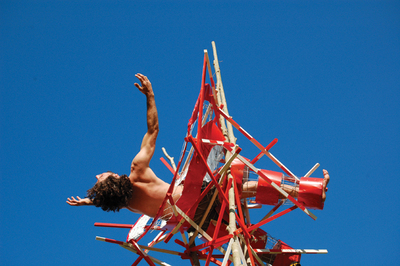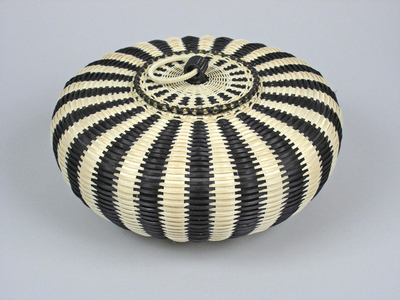You Can’t Get There From Here and Ephemeral Art in the Landscape
Jon Taylor, 30′ Radio Tower & Pants, 2006. Courtesy of I-Park Foundation, Inc.
In the art world, the biennial (or biennale in Italian) is a concept referring to an event that happens every two years. Two current examples in the region are this year’s Portland Museum of Art Biennial in Portland, ME, and the I-Park Foundation Environmental Biennale in East Haddam, CT.
The biennial concept debuted early in Maine, with the Photography Maine exhibition at the Maine State Museum in 1973. It then subsequently went on to rotate among several of the state’s art institutions and museums, even getting financial support from the Maine State Legislature in 1988. The chief goal of the so-called “All-Maine Biennial” was to celebrate and showcase contemporary art made in Maine or by those artists having meaningful and significant connections to the state. It was the premier occasion for the state’s younger and lesser-known artists to step out onto the visual arts arena; to try and garner critical attention from art critics and introductions to art dealers, gallerists, and other museum professionals; and to gain recognition from the community at large, including validation from their peers.
The biennials were highly anticipated, charged and lively affairs for the state’s visual arts community, even for those applicants not selected. It was not unusual for the Union of Maine Visual Artists, the state’s only artists’ advocacy group, to take up their cause, even threatening to hold its own Salon des Refusés (French for “exhibition of rejects”).
For some time, the biennials frequently changed locations and loosely alternated between both juried and curated formats. The concept eventually became a mainstay on the state’s arts calendar when it was finally embraced by two of Maine’s most important visual art institutions: the Center for Maine Contemporary Art (CMCA), which started their biennial in 1998 when the organization was still known as Maine Coast Artists; and the Portland Museum of Art (PMA), which started its in November 1998, switching to a spring schedule for subsequent shows. Thus, an annual occurrence of a Maine biennial takes place, curiously enough, with the CMCA hosting in the even years and the PMA in the odd.
Jeremy Frey (Passamaquoddy Tribe, born 1978), Urchin Basket, 2007, brown ash, sweetgrass, dyes, 4 x 8″. Abbe Museum, museum purchase, Diane Kopec Collection Fund. On view at the PMA Biennial You Can’t Get There From Here.
This year’s 2015 PMA biennial, You Can’t Get There From Here, is guest-curated by Alison Ferris, curator of the John Michael Kohler Art Center in Sheboygan, WI. No stranger to the Maine arts scene, Ferris was formerly curator at the Bowdoin College Museum of Art and assistant director of the Maine Arts Commission, and she has been a Maine resident for the last 20 years. It was with these credentials in mind that Jessica May, the PMA’s chief curator and the curator of the 2013 biennial, invited her.
The title of this year’s Biennial is actually an old Maine catchphrase, oft given when directions are asked of a local. The quote is lifted right out of Marshall Dodge’s “Bert & I” comedy skit, “Which Way to Millinocket?” with the lines, “Come to think of it, You can’t get there from here.” For Ferris, it is a metaphor for the artistic processes of each of the 28 biennial artists. In Ferris’s words, it “describes the process that goes into generating art, a modus operandi that is generally hard to explain and a challenge to navigate. It is this emblematic characteristic of Maine’s natural features—in which there is often no straightforward way to getting from point A to point B—that resonates most in the artists’ works included in the 2015 PMA biennial.”
PMA director Mark Bessire says the biennial enables the PMA to show its support for the next generation of great artists. He is quick to point out that, “at one time, all art was contemporary.…Whether it is Hartley, Nevelson, or even Homer, when they first showed their work it was often misunderstood, but the test of time proved the value of their progressive vision.” He further offers an invitation to “enter the biennial with open eyes and a willingness to see a reflection of the times in which we are living. The Maine art tradition is only as good as the last great work that is made. Come see who you think will join the Maine art history canon.”
Patricia Brentano Bramnick, Endangered, Threatened and Special Concern Birds of Connecticut, 2009, painted aluminum. Photo: Wendy Carlson. Courtesy of I-Park Foundation, Inc.
Just over 200 miles south is the I-Park Foundation. It, too, hosts a biennial exhibition: this year, the 2015 I-Park Environmental Art Biennale, Ephemeral Art in the Landscape.
Situated on 450 bucolic acres in a quiet corner of Connecticut, the I-Park Foundation lies smack dab between Boston and New York City, approximately two hours from each. Despite its rural location, artists have managed to find their way to the I-Park Foundation through such organizations as the Alliance of Artists Communities, online searches and through artists’ word of mouth.
I-Park is a top-notch artist residency program. The facility is surrounded by parkland punctuated by 26 trails that exhibit more than 15 years’ accumulation of site-specific works. Some appear to have just been made while others are in varying states of disintegration, an effect both enchanting and otherworldly. These short-lived artworks exist temporarily and are purposefully left to meld back into the surrounds unaided.
I-Park co-founders Joanne Paradis and Ralph Crispino purchased the land in 1998, and—despite having other plans for the property—acquiesced to unsolicited requests by artists to create works on their land. Paradis says, “All we did was say ‘yes’ and the results were both exciting and engaging, and in 2007 we committed to a special residency devoted solely to this type of work. The following year we did it again but found it exhausting. In 2009, we decided to do it again but going forward as a biennial endeavor and called it the I-Park Environmental Art Biennale.” The goal was to invite international, multidisciplinary artists together to immerse them in the natural environment to create site-specific, ephemeral works.
This year, the fifth anniversary of the I-Park Environmental Biennale, 12 jury-selected artists are invited to immerse themselves in a three-week, multidisciplinary, environmental residency program. It will end and culminate in a sterling one-day event: the 2015 Environmental Art Biennale, Ephemeral Art in the Landscape, on Sunday, September 20th, a spectacular day of art-inspired activities that includes studio visits with the artists, performances and inspired walks in an unparalleled natural setting.
Biennial or biennale, the meaning is the same: an art event that happens every two years. Fall 2015 provides us with these two fantastic opportunities to discover new art, artists and ideas in our own backyards, right here in New England.
Andres Azucena Verzosa is co-editor of the forthcoming book Art in Maine: Contemporary Perspectives (University of Maine Press, 2015).



